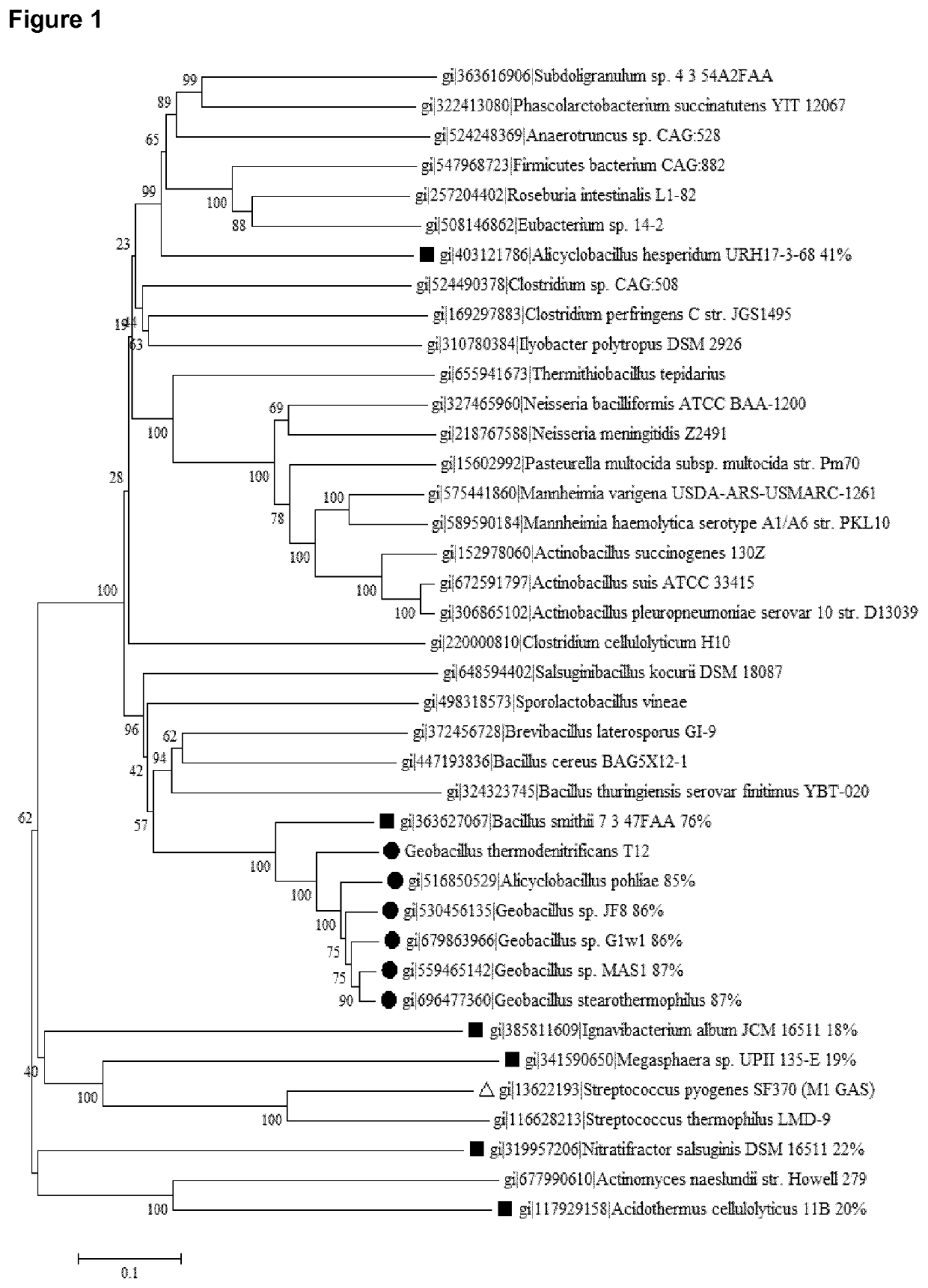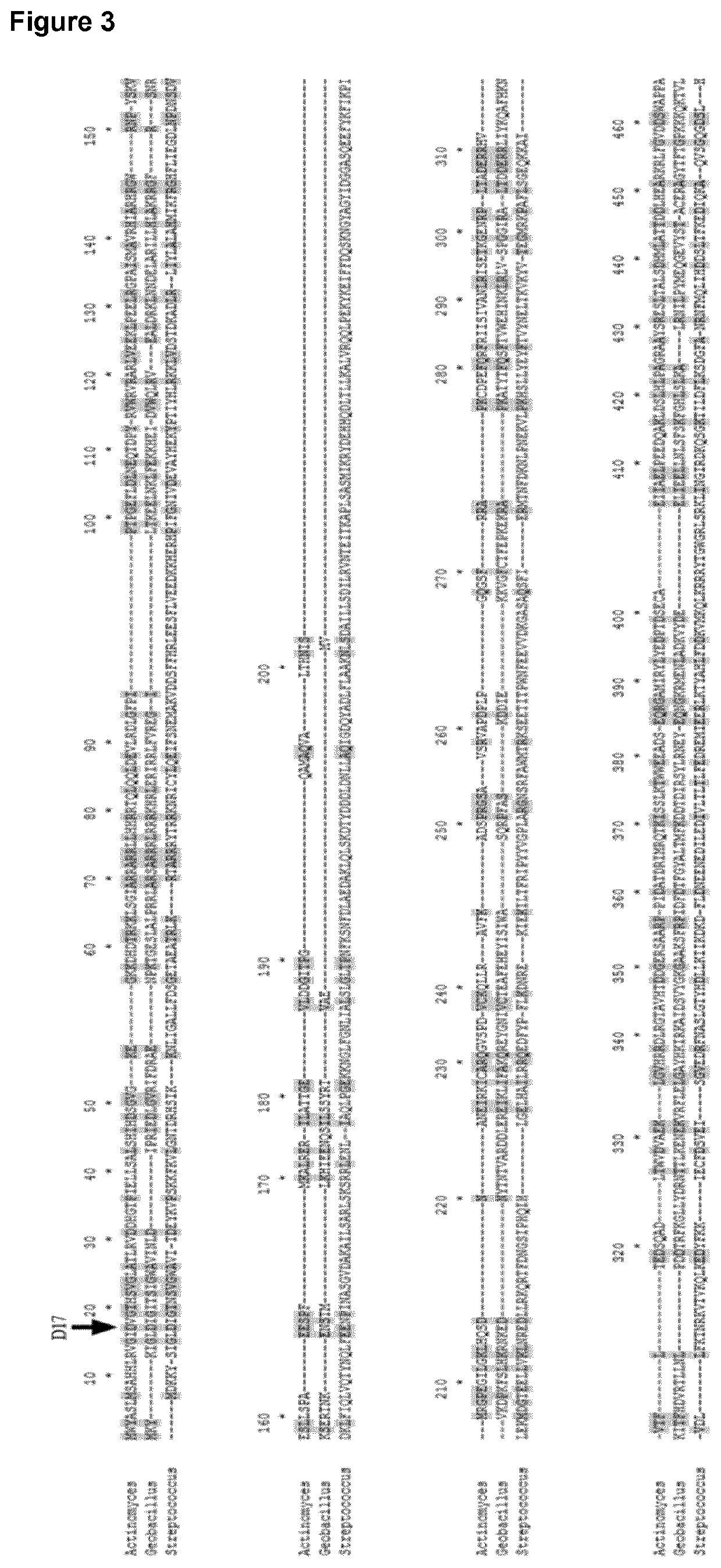Thermostable cas9 nucleases
a technology of cas9 and nucleases, applied in the field of gene engineering, can solve the problems of inapplicability of sequence-specific genome editing tools, including cas9, to all conditions or organisms, and is not applicable to use in strictly thermophilic microorganisms, and achieves no experimental evidence of active cas9 proteins in thermophiles
- Summary
- Abstract
- Description
- Claims
- Application Information
AI Technical Summary
Benefits of technology
Problems solved by technology
Method used
Image
Examples
example 3
ng Core Amino Acid Motifs which are Essential for the Function of CAS9 and Those which Confer Thermostability in Thermophilic Cas9 Nucleases
[0297]Percentages identity of the above described aligned protein sequences are provided in FIG. 1. gtCas9 belongs to Type II-C. The best-studied and recently crystallized structure of a Type II-C system is from Actinomyces naeslundii (Jinek et al., 2014, Science 343: 1247997). This protein sequence shows only 20% identity to gtCas9 but can be used to estimate highly conserved residues. Two well-characterized Type II-A systems (S. pyogenes and S. thermophilus) were also included in the analyses (Jinek et al., 2014, Science 343: 1247997; Nishimasu et al., 2014, Cell 156: 935-949). Alignments of these four protein sequences are shown in FIG. 3; FIG. 4 shows the protein architecture as determined for A. naeslundii (‘Ana-Cas9’) (Jinek et al., 2014, Science 343: 1247997). The length of Cas9 from t12 (gtCas9) and Actinomyces naeslundii is highly simil...
example 5
neration with Randomized PAM
[0303]Two different spacers from the CRISPR II loci of the G. thermodenitrificans T12 strain were amplified by PCR using the G. thermodenitrificans T12 genomic DNA as template. Two pairs of degenerate primers were used for the amplification of each spacer:
[0304]Firstly, a pair that cause the introduction of six random nucleotides upstream of the “protospacer” fragment were used, leading to the production of a pool of protospacers with randomized PAM sequences.
[0305]Secondly, a pair that cause the introduction of six random nucleotides downstream of the “protospacer” fragment were used, leading to the production of a pool of protospacers with randomized PAM sequences.
[0306]The produced fragments were ligated to the pNW33n vector, producing 4 pools of “protospacer” constructs, with all the possible 4096 different combinations of 6-nucleotide long PAMs each. The assembled DNA was used for the transformation of G. thermodenitrificans T12 cells. The cells were...
example 6
Determination of PAM Sequences for gtCas9
[0307]Construction of the pRham:Cas9gt Vector
[0308]The cas9gt gene was PCR amplified from the G. thermodenitrificans T12 genome, using the BG6927 and BG6928 primers, and combined with the pRham C-His Kan Vector (Lucigen) in one mixture. The mixture was used for transforming E. cloni thermo-competent cells according to the provided protocol. 100 μl from the transformation mixture were plated on LB+50kanamycin plates for overnight growth at 37° C. Out of the formed E. cloni::pRham:cas9gt single colonies 3 were randomly selected and inoculated in 10 ml LB medium containing 50 μg / ml kanamucin. Glycerol stocks were prepared from the cultures by adding sterile glycerol to 1 ml from each culture up to a final concentration of 20% (v / v). The glycerol stocks were stored at −80° C. The remaining 9 ml from each culture were used for plasmid isolation according to the “GeneJET Plasmid Miniprep Kit” (Thermoscientific) protocol. The plasmids were sent for ...
PUM
| Property | Measurement | Unit |
|---|---|---|
| temperature | aaaaa | aaaaa |
| temperature | aaaaa | aaaaa |
| temperature | aaaaa | aaaaa |
Abstract
Description
Claims
Application Information
 Login to View More
Login to View More - R&D
- Intellectual Property
- Life Sciences
- Materials
- Tech Scout
- Unparalleled Data Quality
- Higher Quality Content
- 60% Fewer Hallucinations
Browse by: Latest US Patents, China's latest patents, Technical Efficacy Thesaurus, Application Domain, Technology Topic, Popular Technical Reports.
© 2025 PatSnap. All rights reserved.Legal|Privacy policy|Modern Slavery Act Transparency Statement|Sitemap|About US| Contact US: help@patsnap.com



